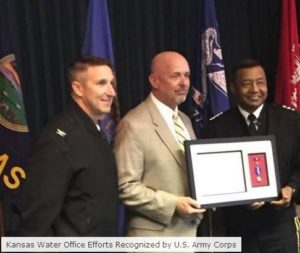Kansas Water Office Efforts Recognized By U.S. Army Corps

This project is the first and largest inland Section 408 request -permission for the alteration of a USACE civil works project- in the nation to be approved by USACE, Headquarters.
Lieutenant Gen. Thomas P. Bostick, the U.S. Army Corps of Engineers Commander, and Col. Richard A. Pratt, Tulsa District, Commander, presented the award to the KWO as well as former KWO employee, Susan Metzger, noting the efforts by the office reflect highly upon the state of Kansas and the nation.
“The KWO’s commitment to delivering enduring and essential water resources solutions to our nation through successful completion of all needed elements for review and approval of the John Redmond Dredging Initiative was commendable,” Gen. Bostick said.
“Ms. Metzger’s demonstration of expert-level knowledge and skills in managing the drafting of technical elements of the Programmatic Environmental Impact Statement, was pivotal for the successful completion of this effort by KWO.”
Since 1964, John Redmond has lost an estimated 42 percent of its conservation pool storage capacity, 80 percent more than originally projected by the USACE at the time the reservoir was completed.
While there have been many short and midterm alternatives to reduce sediment or increase storage through streambank restoration projects and a two-foot pool raise and reallocation, these efforts alone will not remedy the sedimentation rate alone.
“Our work to dredge John Redmond Reservoir is part of our effort to preserve and extend water resources in Kansas,” said Governor Sam Brownback. “Increasing its storage capacity is an important part of our vision to preserve water resources in Kansas. I commend the efforts in protecting this vital resource.”
Dredging sediment from the conservation pool would restore water supply storage for the benefit of the regional water users and restore the lost aquatic habitat for the benefit of public recreation and the lake ecosystem.
The first dirt work began in November 2015 and the official dredging will start this spring.


Leave a Reply
Want to join the discussion?Feel free to contribute!